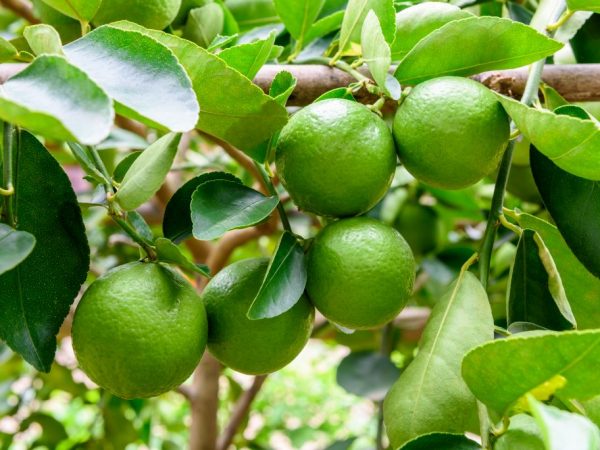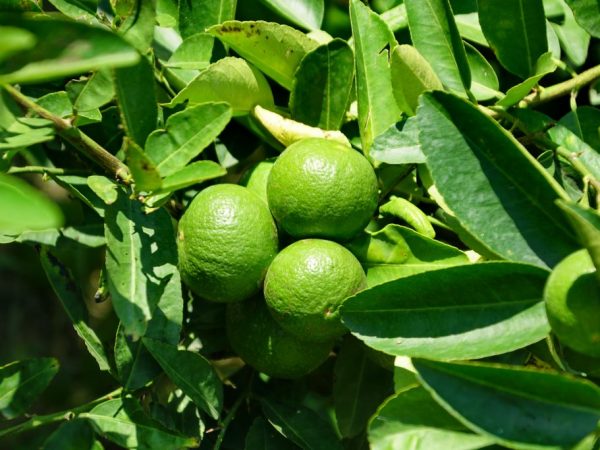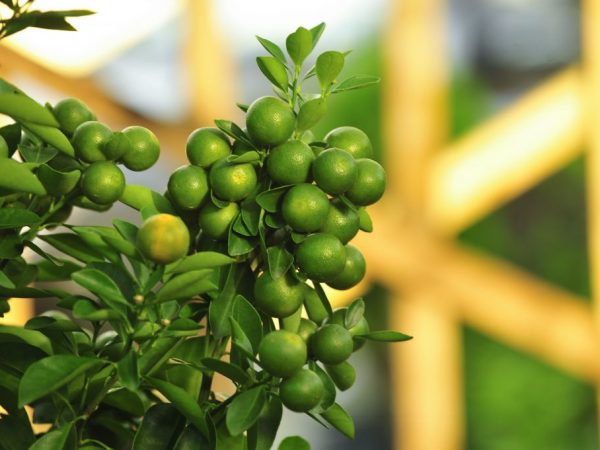Lime fruit
It is important for the human body to get a certain amount of vitamins, minerals and other nutrients. They are found in salads or juices. Each vegetable or fruit is a small chemical laboratory with a set of trace elements. Lime is an excellent citrus fruit that can replace other fruits in its beneficial properties.

Lime fruit
Lime characteristic
Lime is an unpretentious plant that survives on rocky, rocky and sandy soils. In natural conditions, the lime shrub lives for 50-70 years. Prefers the humid and hot climate of the tropics, does not tolerate temperature drops below -2 ° C. Where a lemon or other citrus hybrid doesn't grow, the lime berry thrives.
Interesting facts about the appearance of this fruit: the birthplace of lime (Citrus aurantiifolia) is the Malacca Peninsula, which is located in southeast Asia. It belongs to the Rutaceae family and the Citrus genus. It was spread among other countries in the 1st century. BC e., and Europe learned about it only in the 18th century. It was brought by Arab sailors.
Description of the plant
Lime fruit grows on a bush:
- reaches a height of 5 m;
- strongly branching;
- covered with thorns;
- unstable to cold weather.
According to the description of the plant, the leaves are oval, dark green in color, completely smooth, 6x4 cm in size. They are attached to a petiole with a rounded lionfish.
Lime, in addition to the size of the tree, amazes with beautiful year-round flowering. Small, white flowers up to 2 cm in diameter. In the axils of the leaves, inflorescences of 2-8 flowers are formed in May-June. First fruiting at 4-5 years of plant life. There is lime, they begin in August, when it is fully ripe.
Description of fruits
The first shoots and fruits appear on the sunny side. The fruits have characteristic features:
- oval or ovoid shape;
- size up to 5 cm in diameter;
- thin peel;
- the color of the peel is bright green or greenish yellow;
- flesh with a characteristic green color;
- few seeds (no more than 3).
Lime is a green fruit, small, with a juicy, uniform consistency, pulp.
The aroma is pleasant, fresh and strong. Externally similar to lemon, which is a hybrid of lime and crossed with another citrus called etroga. The difference lies in the peel, which in lime is much thinner and has a more intense green hue. Therefore, lime has a second name - green lemon. Real lime has a sour taste and is green in color with white veins on the slices.
This fruit has many varieties that divide it into sweet and sour groups in taste.
Growing lime at home

Protect the plant from sunburn
Breeders have developed decorative varieties that are very popular with those who want to decorate the room with live plants and taste the lime from their own tree.
Lighting
In the room for the plant, the east and west sides are chosen, where direct sunlight does not fall. Daylight hours should be 10-11 hours, if the side is north, illuminate with a lamp. On the south side, do not put the plant pot on the windowsill. Heat and sunlight reflected from the glass will destroy the tree.
Temperature regime
In the spring and summer, the indoor temperature should be maintained between 32-35 ° C, and in the autumn and winter months at least 9-16 ° C. If the temperature regime is not observed, the plant slows down its growth and development. The ovary and buds will fall off during a cold snap and fruiting will not occur.
Watering and humidity
Lime is a citrus fruit from the tropics. He loves moisture and heat, which are detrimental to other fruits. Home growing conditions should be close to natural conditions. In the summer months, the following procedures are carried out:
- spraying with warm water;
- rinsing the crown under the shower;
- a humidifier is placed next to the plant.
Water for spraying must be defended in order to get rid of chlorine. When watering the crown from the shower, cover the soil in the pot with a film so that it does not get wet. If there is no air humidifier, then a pot with a plant is installed in a container with expanded clay or sphagnum moss, dipped in water.
Watering is carried out as the soil dries up in the root zone. In winter, watering is reduced. The plant and soil are inspected to determine when to water. If the soil crumbles in your hands when squeezed, it should be watered immediately. For watering, it is better to choose distilled water if the tap is hard. The distillate is replaced by rain or river water. The optimum temperature for watering is 25 ° C.
Top dressing
During the period of active growth, a feeding procedure is carried out. Lime is a fruit that loves to alternate complex mineral fertilizers with organic ones. From this, its leaves become beautiful, dense and bright green.
Top dressing is applied every 14 days. Rotted mullein is used as an organics. Before the winter period, feeding is not carried out if the temperature is below 10 ° C. In other cases, moderate doses of fertilizers are applied monthly after abundant watering. In this case, the root system will not burn.
Lemon and other citrus fruits like fish complementary foods, which will require boiling 250-200 g of fish in 2 liters. water for 15-20 minutes. Then cool and dilute with water 1: 2, strain through a colander or cheesecloth. If you carry out such top dressing monthly, then the tree will grow up to 1 m.
Transfer

The tree needs annual replanting
Young limes are transplanted annually in winter or in the first week of March. As soon as the tree grows up, the top layer of soil is replaced without transplanting into a new pot, if the roots still fit freely in the old one, do not look out of the drainage holes.
A ceramic pot is selected for transplantation (it breathes better). At the bottom, in which there is a hole for the drain of excess water, drainage (expanded clay or broken brick) pours out.
Transfer is the best way to transplant citrus fruits. The root collar is not buried, it remains at the soil level after watering. Otherwise, the trunk may rot.
The potting mix is bought or prepared by yourself. It is made in several ways: from turf, humus, leafy soil and river sand in equal proportions, or from peat soil, turf, foliage and large fractions of sand (1: 1).
Reproduction methods
To grow real lime on your own, you can graft, vaccinate or plant seeds.
For the growing season, a branch is cut from the original plant, from its upper part, 15 cm long and the presence of 5 buds. 2-3 leaves are left. The cut is made even, with a sharp pruner or garden shears. After that, the cut is processed in a solution with a root formation stimulator.
Disembarkation is carried out in wet sand, under a bottle, with the neck and cork up.By opening the plug, it is easy to ventilate and moisten the soil. The place for the plant is chosen illuminated and with the required air humidity. After 30 days, the cut branches will take root. They are transplanted into other pots with a large diameter - up to 7-8 cm.
Propagation by a bone begins with its washing and drying. After that, the bone is planted in a prepared pot, with drainage and a drain hole. The soil is selected sandy, well-ventilated, universal for flowers and citrus fruits. Greenhouse conditions are created with the necessary air and soil moisture. The room temperature is maintained between 25-27 ° C.
Shoots appear in 2-3 months. There are several of them from the bone. When 2-3 true leaves have developed, the strongest plant is selected and the rest are cut with sharp scissors.
The pick is done in separate containers, with drainage and moistened sandy soil.
Pests and diseases
To get a healthy harvest, preventive and curative measures are taken.
Scabbard, aphids, spider mites and mealybugs can damage the tree and the fruit on it. Regularly inspect how its leaves and branches look.
With a disease, brown spots appear on the lower part of the leaves, the plate is deformed and becomes sticky. The peel of the fruit and the tips of the branches turn yellow. When black and green beetles appear on the back of the leaves, formations similar to cotton wool appear in their nodules.
If you find these symptoms, start treatment quickly, otherwise the whole plant will die. The branches and leaves are treated with soap or alcohol solution. The sooty fungus is removed with cotton swabs dipped in a medicinal solution. An insecticide such as Aktar or Aktelika helps well. Insects are removed by hand.
Disease gommosis manifests itself on the trunk in the form of cracks, with a sticky liquid. The reason lies in the wrong deep planting, with the deepening of the root collar and waterlogging of the soil.
For treatment, disinfection is carried out with a 3% solution of copper sulfate. The trunk is processed with garden pitch or lime with vitriol.
Direct sunlight damages the leafy crown, which becomes covered with drying spots. When the air is dry, the tips of the foliage dry out, and the plant inhibits its development.
Conclusion
This fruit, amazing in its taste, contains ascorbic acid and potassium, which the body lacks after the winter period, and in particular the circulatory system, to lower cholesterol levels. It slows down the aging process, improves cell regeneration. Growing such a healthy citrus at home is not difficult using simple gardening rules.


